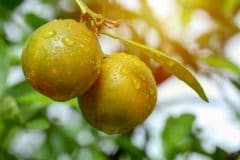Top Orange-Producing Countries
Nearly 50 percent of the world’s commercially grown oranges come from five sources:
- Brazil (33 percent)
- China (16 percent)
- The EU (12 percent, nearly half of it from Spain)
- Mexico (9 percent)
- The United States (7 percent – a severe decline due to Florida’s problems with citrus greening disease and climate changes.)
Turkey, Morocco, South Africa and Egypt also produce oranges commercially. Surprisingly, one of every three oranges grown for the export market comes from Egypt.
The Orange-Friendly Environment
As subtropical trees, oranges find an environment to their liking in many parts of USDA plant hardiness zones 9 through 11. Grafted to cold-hardy rootstock and given winter protection, some even bear fruit in USDA zone 8. Just what do they like?
Temperature
Oranges thrive where growing-season temperatures consistently range between 55°F and 100°F (12.8°C to 37.8°C). During winter dormancy, they’re happiest between 35ºF and 50°F (1.7°F and 10°C). Readings of 26°F to 30°F (-1.1°C to 13.3°C) damage the fruit while young trees often die when exposed to brief frost.
Sun and Rain
Orange trees need from eight to 12 hours of daily sun. Mature, fruit-bearing trees also need at least 60 inches of water per year – with about 90 percent of it coming during the growing season. Because sunny days seldom produce rain, spring-through-fall irrigation is a regular part of orange tree care.
Irrigation Amounts
In the heat of summer, a mature orange tree with a 20-foot wide canopy may need the equivalent of 60 gallons (227 liters) of water per day, delivered via slow, deep irrigation every week to 10 days. Between November and February, when rain is more likely, the same tree requires just 7 ½ to 11 gallons (28 to 41.5 liters) per day.
Soil
Orange trees accept both sandy and loam soils, as long as they:
- Drain well.
- Have a slightly acidic to neutral pH between 6.5 and 7.0.
- Allow deep root development.
Orange trees in alkaline soils decline slowly from mineral deficiencies. Those growing where the water table is less than 30 inches beneath their lowest roots are smaller than normal, with decreased flowers and fruit.












